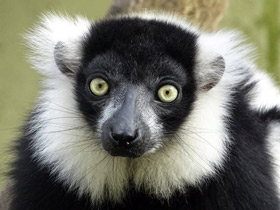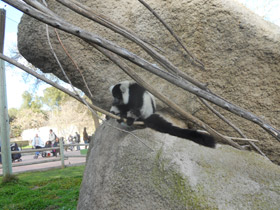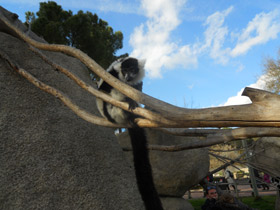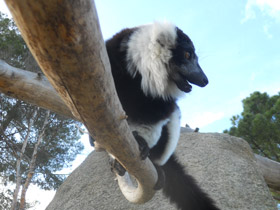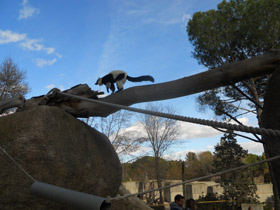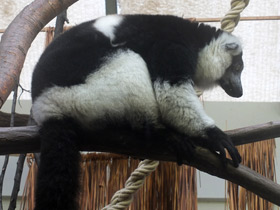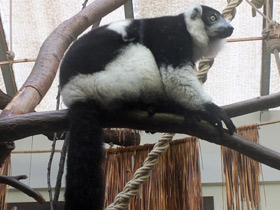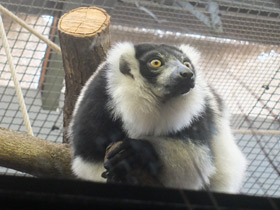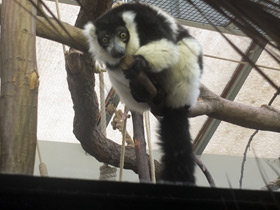The black-and-white ruffed lemur (Varecia variegata)
Black-and-white ruffed lemur видео
The black-and-white ruffed lemur (Varecia variegata) is an endangered species of ruffed lemur, one of two which are endemic to the island of Madagascar. Despite having a larger range than the red ruffed lemur, it has a much smaller population that is spread out, living in lower population densities and reproductively isolated. It also has less coverage and protection in large national parks than the red ruffed lemur. Three subspecies of black-and-white ruffed lemur have been recognized since the red ruffed lemur was elevated to species status in 2001.
Description and distribution
Varecia variegata is a species of strepsirrhine primate in the family Lemuridae.
The genus Varecia variegata is now considered to include 2 species of lemurs (formerly considered subspecies) - the fur of Varecia variegata is black and white, the fur of red Varecia variegata is naturally red and black. Both species are endemic to Madagascar, where they inhabit isolated areas of rainforest up to 1200 m above sea level.
The red Varecia variegata is found in north-eastern Madagascar (Masoala peninsula, near the town of Maroansetra). The Antainambalana River serves as a natural barrier and delimits the habitat of the red and white Varecia variegata.
The Varecia variegata is one of the largest lemurs: its body length reaches 100-120 cm, of which about 60 cm is due to the exuberant fluffy tail; the weight is 4 kg.
These diurnal primates spend most of their time in trees. Varecia variegata feeds mainly on plant food, such as leaves and tree fruits, but also occasionally catches small invertebrates.
Behaviour and reproduction
Varecia variegata live in small groups of 5 to 20 animals, dominated not by the male but by the larger adult female. Each family has its own territory, which it actively defends from outsiders.
When the mating season arrives, these silent lemurs begin to emit very loud and unusual sounds, which would rather belong to some much larger beast. These sounds are transmitted throughout the forest and can be heard from a great distance.
Varecia variegata breeds in March/April. After a gestation period of 120 days, the young weigh around 80 g. The number of newborns may be as many as six, but three are the most common.
Varecia variegata are the only primates that can give birth to so many newborns and the female can theoretically suckle all six, as she has six nipples. Unlike other primates, female lemurs do not carry their young on their backs when foraging for food. They leave their young in nesting shelters, which they make from tree leaves and line with their own fur. The lemur cubs cannot cling to the female's fur, so, if necessary, she carries them between her teeth.
During the first two months, the mother does not allow even the father to come near the cubs, which nevertheless remain on her property. When the cubs get a little older, she starts to take them with her. At first the cubs travel on her belly, then they move to their mother's back. The two-month-old cubs already play with their father.
In the wild, the Varecia variegata has a lifespan of 15 to 20 years; in captivity, it lives up to 30 years.
Diet
Wild black-and-white ruffed lemurs have a highly frugivorous diet, with fruit making up 92% of their overall diet. Smaller percentages of leaves, nectar, seeds, and even fungi make up the remainder. Their diet is also influenced by the seasons, with certain plant parts and fruits only ripening or becoming available during certain times of the year. Water consumption also varies throughout the year and can be influenced by diet. The number of tree species utilized for food by the lemurs can range from 19 to 40 species depending on location. The larger part of fruit items in the diet is provided by four taxa of fruit trees: Ravensara species, Chrysophyllum boivinianum, Protorhus species, and Harungana madagascariensis.
Taxonomy
The black-and-white ruffed lemur is one of two species in the genus Varecia, the other being the red ruffed lemur (Varecia rubra). Three subspecies are recognized: the white-belted black-and-white ruffed lemur (Varecia variegata subcincta), the Hill's ruffed lemur, (Varecia variegata editorum), and the black-and-white ruffed lemur (Varecia variegata variegata, the nominate subspecies).
Varecia variegata in the Red Data Book
Varecia variegata is listed as Critically Endangered in the IUCN Red List. The main cause of its decline is habitat destruction, as well as hunting and poaching.
Subspecies
- Varecia variegata subcincta;
- Varecia variegata variegata variegata;
- Varecia variegata editorum.

















